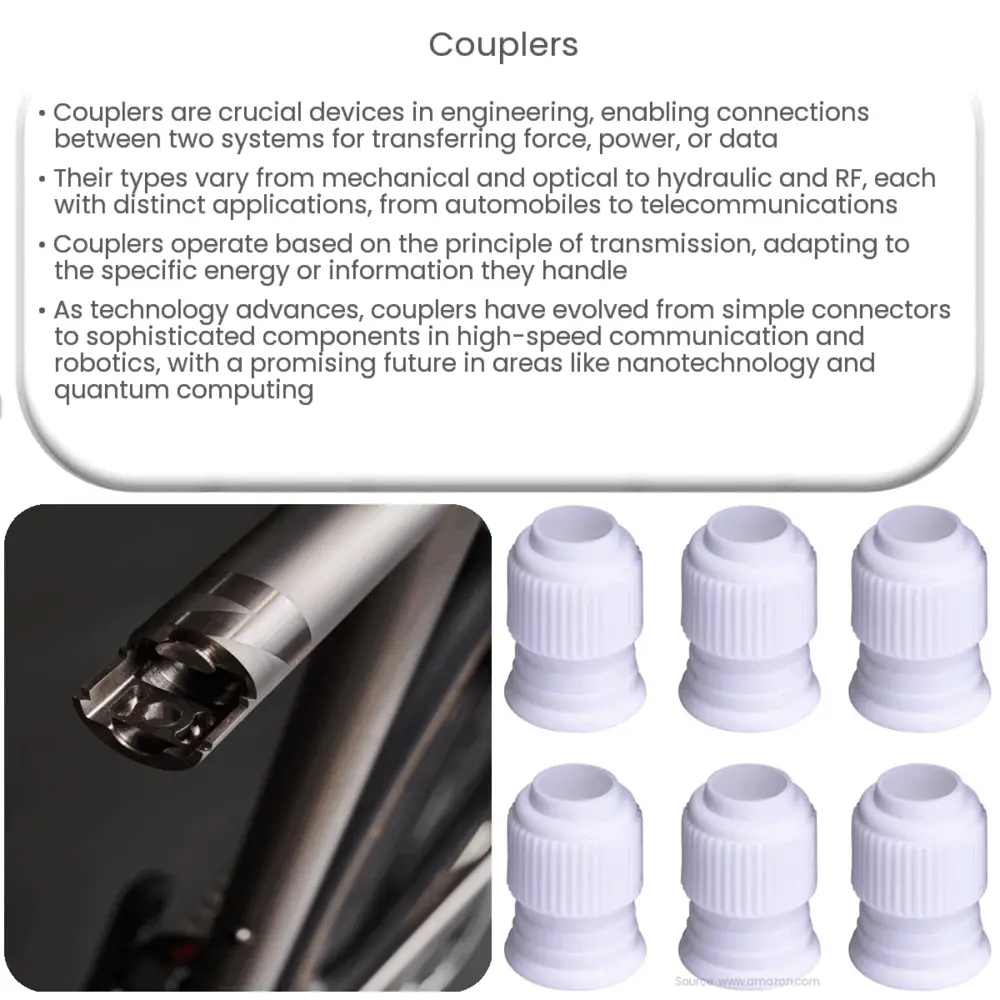Explore the role of couplers in technology, their types, working principles, evolution, and potential future developments.

Understanding Couplers
In the broad realm of engineering and technology, a coupler is a pivotal element, and its roles are as varied as the fields themselves. Fundamentally, a coupler is a device that facilitates the connection between two systems, enabling the transfer of physical quantities such as force, power, or data.
Different Types of Couplers
The types of couplers depend vastly on the context and the nature of the elements they are connecting. However, to provide a general understanding, let’s delve into some typical types of couplers.
- Mechanical Couplers: As the name suggests, mechanical couplers are used in various mechanical systems, such as those in automobiles and industrial machinery. They connect two rotating systems, allowing the transmission of power or motion from one part to another.
- Optical Couplers: In the realm of optical technology, optical couplers split or combine light signals, facilitating signal processing in telecommunications, data communications, and medical applications.
- Hydraulic Couplers: Hydraulic couplers connect sections of hydraulic systems, allowing fluid power transfer in heavy machinery, agricultural equipment, and hydraulic tools.
- RF Couplers: These are used in electronics, especially in telecommunication systems. They split or combine the power of electromagnetic signals.
Understanding the Working Principle of Couplers
The operation of a coupler is based on a straightforward principle – transmission. It works by establishing a path through which a certain form of energy or information can flow from one system to another. The form this path takes, and the precise manner in which transmission occurs, is highly dependent on the nature of the coupler and the systems it connects. For instance, an RF coupler works on the principles of electromagnetic wave propagation, while a mechanical coupler operates on principles derived from Newton’s laws of motion.
Importance of Couplers in Modern Technology
Couplers play an integral role in many fields of modern technology. They are essential in creating complex, interconnected systems that rely on the exchange of energy, signals, or data. From communications systems, automobiles, industrial machinery, to medical devices, couplers ensure efficient transmission and distribution of resources, thereby enhancing overall system performance.
Designing and Selecting Couplers
Designing and selecting the right coupler for a specific application is a critical task. Engineers need to consider factors such as the nature of the systems to be connected, the type of transmission required, environmental conditions, and more. For instance, a coupler used in a high-frequency radio communication system might need to be resilient to temperature variations and electromagnetic interference. Similarly, a mechanical coupler in an industrial setting would require strength and durability.
Evolution of Couplers
The evolution of couplers mirrors the advancement in technology and the growing complexity of systems. Early forms of couplers were simple and manual, like those used in train cars. However, as technology progressed, the need for automated, more efficient couplers became evident. Today, couplers can be found in their most advanced form in areas such as optical communication systems, enabling high-speed internet connections, and in robotics, making precise movements possible.
Future of Couplers
As technology continues to evolve, so too will the design and application of couplers. Emerging fields such as nanotechnology and quantum computing present new challenges and opportunities. Here, couplers will need to operate on a micro or even nano scale, handling quantum information or manipulating tiny particles. While we are only at the advent of such technology, the future of couplers promises to be as exciting as it is innovative.
Conclusion
In conclusion, couplers serve as a linchpin in connecting different systems, facilitating the transfer of various physical quantities like force, power, or data. They have morphed over time, from simple mechanical devices to complex units assisting in advanced digital communications. The future will undoubtedly see them becoming increasingly central in upcoming technological domains like nanotechnology and quantum computing. Thus, understanding couplers not only helps us appreciate the current state of technology but also prepares us for the fascinating advancements yet to come.

